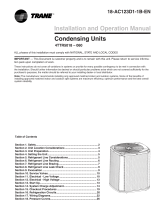
14
4A-V0-SF-1G-EN
Sequence of Operation
CCoonnttrrooll OOppeerraattiioonnaall OOvveerrvviieeww
Operation of the communicating, variable speed
outdoor unit is managed and monitored by a micro
processor based Integrated Variable Speed Control
(IVSC) located in the control box of the outdoor unit.
This component is also referred to as “The Drive”. Heat
and Cool demand messages are transmitted from the
comfort control over the data line from the comfort
control to the indoor and outdoor sections of the
system. System mode and capacity requests are
received by the outdoor IVSC and responded to by
providing control outputs to the switch-over valve
(SOV) solenoid coil, electronic expansion valve (EEV)
stepper motor, condenser fan motor and compressor.
Operating conditions and system commands such as
compressor percent demand, indoor airflow, EEV
starting position, defrost (For auxiliary heat), outdoor
temperature and alerts are transmitted from the
outdoor control over the data line to the rest of the
communicating system. Additional data that is
communicated to the rest of the system includes the
type of equipment installed (variable speed, unit size in
nominal tonnage, heat pump or air conditioner) which
is used during the Auto Discover function to set indoor
airflow and configure the comfort control for the
equipment installed
The IVSC has two Light Emitting Diodes (LED) used for
indicating operating status and verifying
communications. The STATUS LED flash rate indicates
if the system is in standby (or idle), receiving capacity
demand from the comfort control, in a test mode or in a
lockout condition. The COMM LED indicates successful
communications by flashing a device count which can
be used to verify how many communicating devices
are connected to the data line.
A Communicating Display Assembly (CDA) is
connected to the IVSC and is used to monitor,
configure, test and provide feedback about the system.
CCoooolliinngg MMooddee ((AA//CC aanndd HHeeaatt PPuummpp))
When a request for cooling capacity is sent from the
communicating comfort control to the outdoor unit, the
IVSC will respond by flashing the STATUS LED two
times per second and the CDA will display COOLING in
the SYSTEM STATUS home screen. The IVSC will
calculate the required running speed for the
compressor and outdoor fan based on the current load
value and stage demand sent from the comfort control.
Load values under 100 will generate stage one demand
and the IVSC will generate power to produce the
minimum compressor RPM. Additionally, a CFM
demand message is sent from the outdoor IVSC to the
indoor unit for matching indoor airflow.
Regardless of the load value or stage demand, the
outdoor system will start and ramp to a target startup
speed and hold steady for a minimum dwell period to
ensure proper oil return. This dwell period will typically
last for 1 minute but for initial start ups, after power is
first applied, the dwell period is 15 minutes. The startup
operation will progress to normal operation once this
dwell period is completed. With stage one demand and
minimum compressor RPM, the system will duty cycle
as needed to provide the required capacity requested
from the comfort control. The default duty cycle setting
for stage one demand is 3 Cycles per Hour (CPH). See
the Advanced Settings in the 850/950 Installation Guide
for more information on CPH.
With any start up, a Pulse Width Modulation (PWM)
signal is sent from the J9 plug of the IVSC to the
outdoor fan motor to run at the required matching
speed.
Should system load value rise above 100, stage two
demand is sent from the communicating comfort
control to the outdoor control and the IVSC will
respond by entering the modulating region of
compressor and outdoor fan operation. As load value
increases or decreases in the modulating region, so
will the compressor, outdoor fan and indoor blower
speeds to continuously deliver the capacity requested
by the comfort control and meet the demand of the
structural load. All indoor CFM demand messages will
be sent from the IVSC to the indoor unit so that the
blower motor will run with matching modulating
speeds. The System Report Screen (Located in the 850/
950’s Technician Access menu) or the Monitor Menu
(Located in the outdoor CDA Technicians Control
menu) can be used to view the compressor demand, in
percentage, while in the modulating range.
As system load value drops below 100, stage two
demand is satisfied and the communicating comfort
control returns system operation to stage one demand
and the system will begin to duty cycle as needed to
provide the requested capacity.
HHeeaatt PPuummpp CCoooolliinngg MMooddee ooff OOppeerraattiioonn
In addition to stage and demand operating sequences
outlined in the Cooling Mode description, when a heat
pump system receives a demand message for cooling,
the Switch Over Valve (SOV) solenoid will be pulsed to
position the valve for cooling. Latching Switch Over
Valve (LSOV) technology is standard with variable
speed outdoor heat pumps. By utilizing components
designed to hold the pilot pin of the SOV in place, the
valve will maintain the cooling or heating position even
when power is removed. Maintaining valve position, or
Latching, is accomplished with the help of a magnet
mounted in the solenoid coil or a spring manufactured
internal to the SOV. To initiate the SOV position, a12
Volt DC pulse is sent from the J8 plug located on the
IVSC to the solenoid coil at the start of each call for
capacity. Polarity of the DC pulse is critical to the




















